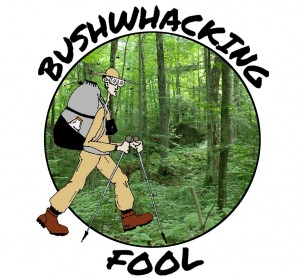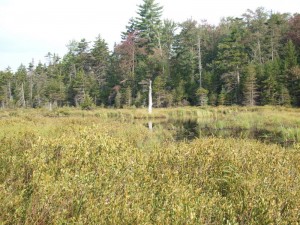
Feeder stream
The following is the first part of a report on the third day of a bushwhacking trip through the interior of the southern portion of the Pepperbox Wilderness. The majority of the trip follows along streams and beaver vlys with the exit from the area following a marked herd path from the wild interior of this wilderness area. Highlights along the trip included the Threemile Beaver Meadow, Bear Pond, Moshier Creek and Moshier Reservoir. The first part of the third day was a bushwhack from Bear Pond up and over a ridge to a feeder stream to the northeast.
Date: September 2, 2010
Length: 0.62 miles (0.62 miles cumulative)
Difficulty: Easy
My night at Bear Pond was less than ideal. A headache and head congestion combined with much leaf rustling and at least one splash out in the pond to make my sleeping experience neither tranquil nor refreshing. So I greeted the third day on my five-day trip through the central portion of the Pepperbox Wilderness groggy and unsteady.
Obviously my bushwhacking legs would be late in coming this morning. Hopefully the early morning terrain would not be too aggressive as I moved east along a feeder stream two-thirds of the way to Moshier Creek.
By 7 AM I was out from under my Golite Cave tarp, dressed and ready for breakfast. As I ate breakfast I took in the sights around my Bear Pond campsite. I noticed the sky was cloudy but the high humidity had not changed from the previous day. As I consumed my cereal I listened to the seasonally-challenged spring peepers which were still calling as they had all night. Very few birds were singing, with the red-eyed vireo being the most insistent of the few individuals in the area.
After breakfast I packed up my campsite and prepared to leave Bear Pond. Before leaving the pond I went down to the shore for one last look-see. While scanning the perimeter of the pond with my Leica 8×20 Ultravid binoculars I spotted a pair of wood ducks swimming along the opposite (western) shore. After watching the two ducks for a several minutes I turned and returned to my campsite to retrieve my Golite Pinnacle backpack.
View Day Three, Part One in a larger map
With my Sliva Ranger compass set to a bearing of 44 degrees I headed uphill and toward the feeder stream of Pepperbox Creek, which I would be following for most of the day. As I was moving away from Bear Pond I could still hear the persistent red-eyed vireo singing behind me.
My plan for the day was climb up and over a ridge and down into the floodplain of the feeder stream to the northeast. Once in the floodplain I would bushwhack up stream until the stream ran parallel with Moshier Creek to the southeast. Somewhere near a beaver pond in this area would be the ideal spot for me to set up my camp for the night. This would leave me in a good position to trek over to Moshier Creek the following morning.
In fifteen minutes of climbing the height of land was reached and I stopped briefly for a rest (point #25). The forest here consisted mainly of hardwoods such as red maple, American beech and yellow birch. The understory was mostly open but contained many glacial erratics. Red-eyed vireos and ovenbirds sang throughout despite the breeding season being long over. A spring peeper chimed in with its repetitive call for a shot duration before once again falling silent.
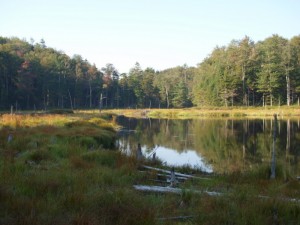
Sun rising on Bear Pond
After examining the paper map, I consulted my Garmin eTrex Legend GPS (with Garmin TOPO 24K northeast maps installed) and decided that instead of staying on my present course I would head more easterly and cut off some of the doubling back that I would inevitably have to do while following the stream.
Soon after starting bushwhacking again, a beaver pond choked with snags blocked my path (point #26) and forced me to bear east even more than I wished. This was just the beginning of wet areas blocking my path forward until I finally turned due east when I spotted what looked to be a large clearing within the trees in that direction (point #27). I was hoping the clearing would be the feeder stream I was planning on following for the remainder of the day.
As I approached the open area to the east the forest quickly transitioned from mixed to entirely coniferous. As I forced my way through, the spruce/fir fought me tooth and nail (or more appropriately branch and needle) but before long the struggle yielded an open area along the feeder stream with its many obligatory deer flies (point #28).
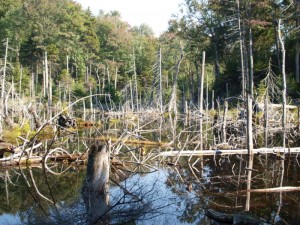
Beaver pond
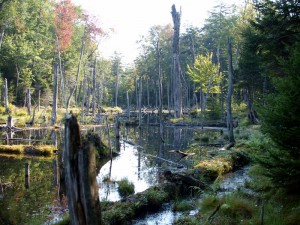
Persistent wet area
Unfortunately, the meadow along the stream was very soggy, so instead of walking in the relatively easy open area, I retreated back into the surrounding spruce/fir forest in an attempt to keep my feet dry. As I would discover following a stream in the thick coniferous forest would be easier said then done.
